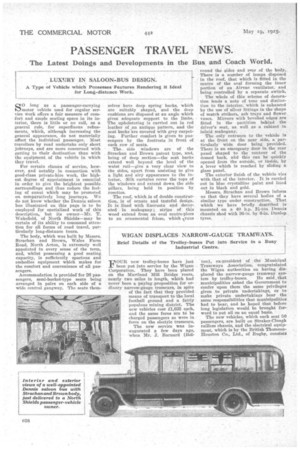WIGAN DISPLACES NARROW-GAUGE TRAMWAYS.
Page 22

Page 23

If you've noticed an error in this article please click here to report it so we can fix it.
Brief Details of the Trolley-buses Put into Service in a Busy Industrial Centre.
FOUR new trolley-buses have just been put into service by the Wigan Corporation. They have been placed on the Martland Mill Bridge route, nearly two miles in length, which had never been a paying proposition for ordinary narrow-gauge tramcars, in spite of the fact that they provided means of transport to the local football ground and a fairly populous mining district. The new vehicles cost £1,635 each, and the same fares are to be charged passengers as were in force on the electric tramcars.
The new service was inaugurated ,a few days ago, when Mr. J. Barnard (Bel
ton), ex-president of the Municipal Tramways Association, congratulated the Wigan authorities on having displaced the narrow-gauge tramway sys tem by trolley-buses. He said ;that municipalities asked the Government to confer upon them the same privileges given to private undertakings, or to make private undertakings bear the same responsibilities that municipalities had to bear, and he hoped that before long legislation would be brought forward to put all on an equal basis.
The new vehicles, which each seat 50 passengers, are built on Straker-Clough railless chassis, and the electrical equipment, which is by the British ThomsonHouston Co,, Ltd., of Rugby, consists of a 42 h.p. electric motor, capable d developing an overload of 05 h.p. for half-au-hour.
The Holden suspension system, which has been fully described in our pages, is employed on the buses. In this system one channel member is bolted to the chassis frame and another inverted and bolted to the underside of the frame. In the box section thus formed rubber tubes are carried, and these are inflated to a suitable pressure so that the body is actually mounted on air cushions. This form of suspension, combined with flexible springs and Dunlop tyres, is said to give very comfortable riding on the new buses.
The bodies were built to the design of Mr. W. Maya11 Milnes, the tramway manager. The seats are fitted round the body sides, and this arrangement is said to make it much easier for the con
ductor to collect fares and tn.-e1A5 pegsenors causing obstruction in the gangway.
The buses have a central entrance 4 ft. wide, which gives ample room for passengers to mount and dismount at the same time, and should facilitate quick leading and unloading, a very essential matter on a short route. The main structure of each of the bodies consists of an oak underframe with the corner pillars of teak and intermediate pillars of ash. It is lined in the lower portion with birchwood panels, the upper portion being finished in oak mouldings and raised panels. The lighting has received special attention. There are four lights in the front saloon, which is the non-smokers' section, one in the vestibule entrance and five in the rear saloon, which is the smokers' compartment.




























